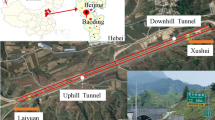Abstract
Stack effect is a dominant driving force for building natural ventilation. Analytical models were developed for the evaluation of stack effect in a shaft, accounting for the heat transfer from shaft interior boundaries. Both the conditions with constant heat flux from boundaries to the airflow and the ones with constant boundary temperature were considered. The prediction capabilities of these analytical models were evaluated by using large eddy simulation (LES) for a hypothetical shaft. The results show that there are fairly good agreements between the predictions of the analytical models and the LES predictions in mass flow rate, vertical temperatures profile and pressure difference as well. Both the results of analytical models and LES show that the neutral plane could locate higher than one half of the shaft height when the upper opening area is identical with the lower opening area. Further, it is also shown that the analytical models perform better than KLOTE’s model does in the mass flow rate prediction.
Similar content being viewed by others
References
DODOO A, GUSTAVSSON L, SATHRE R. Building energy-efficiency standards in a life cycle primary energy perspective [J]. Energy and Buildings, 2011, 43(7): 1589–1597.
CIBSE. Natural ventilation in non-domestic buildings [R]. London: Chartered Institution of Building Services Engineers, 2005.
ANDERSON K T. Theoretical consideration on natural ventilation by thermal buoyancy [J]. ASHRAE Technical Data Bulletin, 1995, 11(3): 48–62.
BANSAL N K, MATHUR R, BHANDARI M S. Solar chimney for enhanced stack ventilation [J]. Building and Environment, 1993, 28(3): 373–377.
BAROZZI G S, IMBABI M S E, NOBILE E, SOUSA A C M. Physical and numerical modelling of a solar chimney based ventilation system for buildings [J]. Building and Environment, 1992, 27(4): 433–445.
van der MASS J, ROULET C A. Night time ventilation by stack effect [J]. ASHRAE Technical Data Bulletin, 1991, 7(1): 23–38.
WONG N H, HERYANTO S. The study of active stack effect to enhance natural ventilation using wind tunnel and computational fluid dynamics (CFD) simulations [J]. Energy and Buildings, 2004, 36: 668–678.
SHERMAN M H. Single-zone stack-dominated infiltration modeling [C]//Proceedings of the 12th IEA Conference of the Air Infiltration and Ventilation Centre. Ottawa, ON, 1991: 297–314.
KLOTE J H. A general routine of analyzing of stack effect [R]. National Institute of Standards and Technology, NISTIR 4588, 1991.
ASHRAE Handbook-fundamentals [R]. Inc Atlanta: American Society of Heating, Refrigerating and Air-Conditioning Engineers, 1997.
KOTANI H, SATOH R, YAMANAKA T. Natural ventilation of light well in high-rise apartment building [J]. Energy and Buildings, 2003, 35: 427–434.
LIM T, CHO J, KIM B S. Predictions and measurements of the stack effect on indoor airborne virus transmission in a high-rise hospital building [J]. Building and Environment, 2011, 46(12): 2413–2424.
MAATOUK K, ASMA A. Stack pressure and airflow movement in high and medium rise buildings [J]. Energy Procedia, 2011, 6: 422–431.
XIAO G Q, TU J Y, YEOH G H. Numerical simulation of the migration of hot gases in open vertical shaft [J]. Applied Thermal Engineering, 2008, 28: 478–487.
MCGRATTAN K, HOSTIKKA S, FLOYD J, BAUM H, REHM R. Fire dynamics simulator (Version5)-Technical reference guide [R]. National Institute of Standards and Technology, 2007: 1018–1025.
Author information
Authors and Affiliations
Corresponding author
Additional information
Foundation item: Project(50838009) supported by the National Natural Science Foundation of China; Project(2010DFA72740-03) supported by the National Key Technology Research and Development Program of China
Rights and permissions
About this article
Cite this article
Yang, D., Li, Bz., Du, T. et al. Analytical models for evaluating buoyancy-driven ventilation due to stack effect in a shaft considering heat transfer from shaft interior boundaries. J. Cent. South Univ. Technol. 19, 651–656 (2012). https://doi.org/10.1007/s11771-012-1052-z
Received:
Accepted:
Published:
Issue Date:
DOI: https://doi.org/10.1007/s11771-012-1052-z




